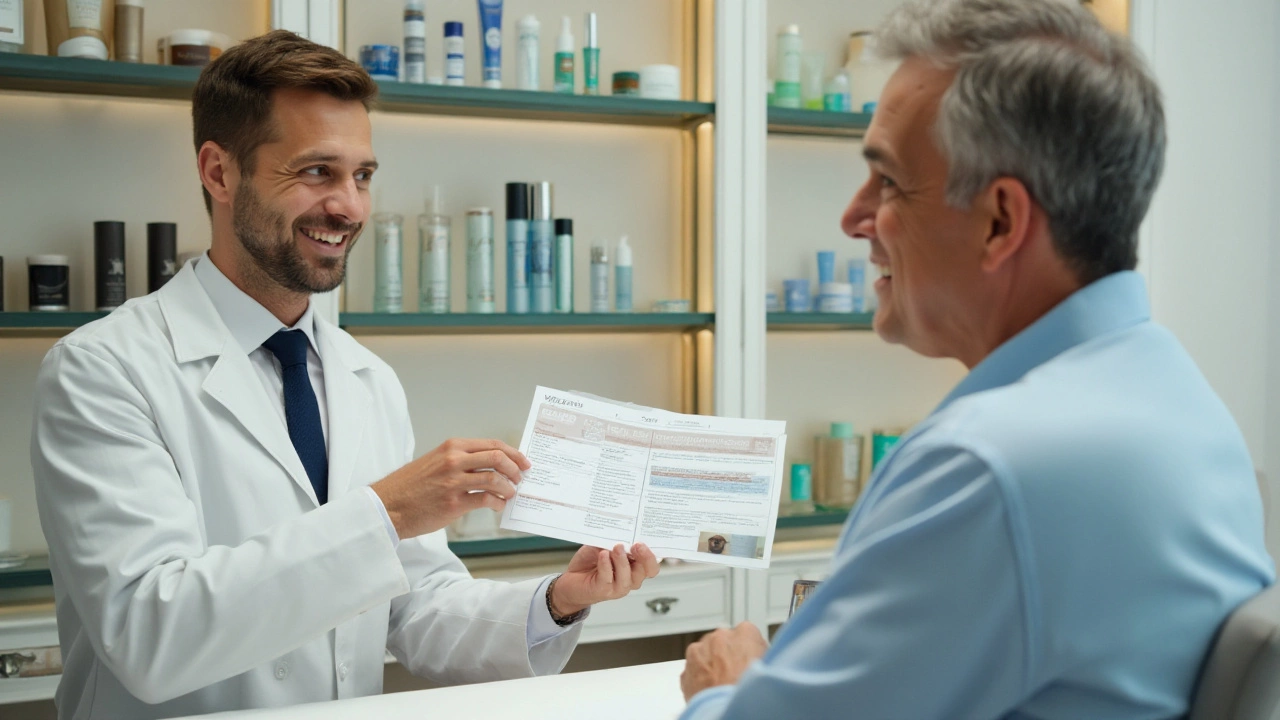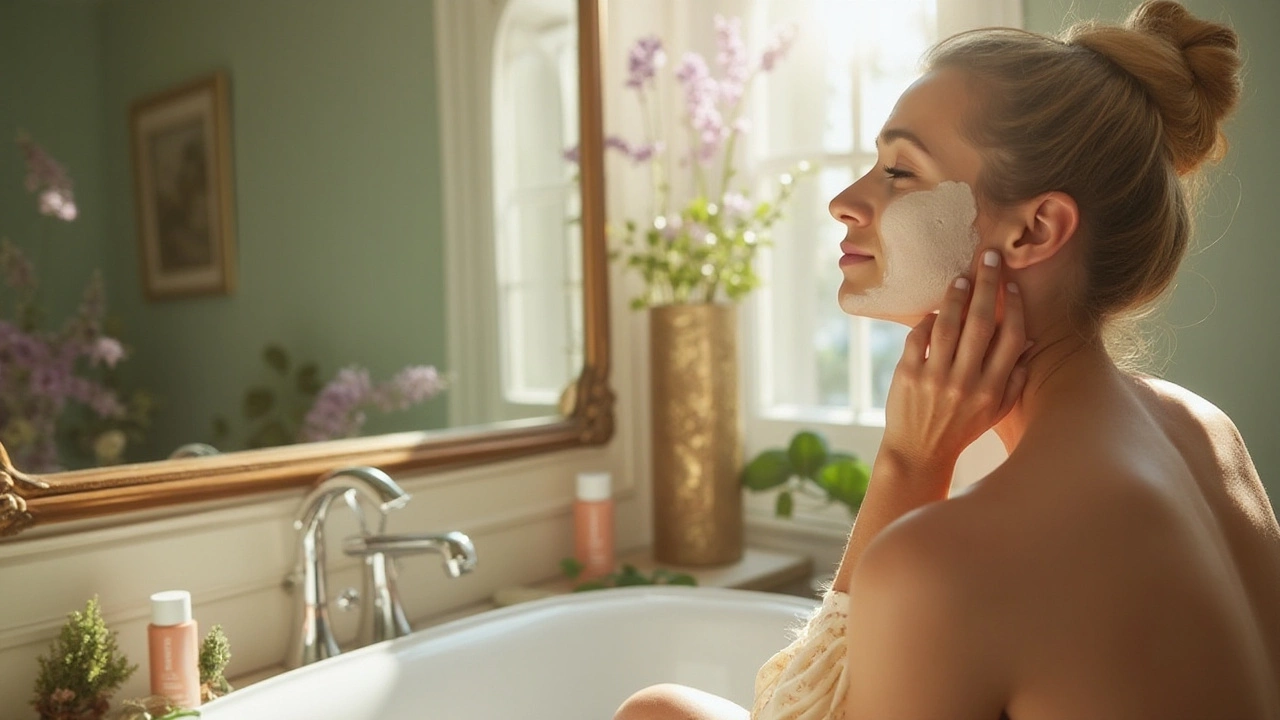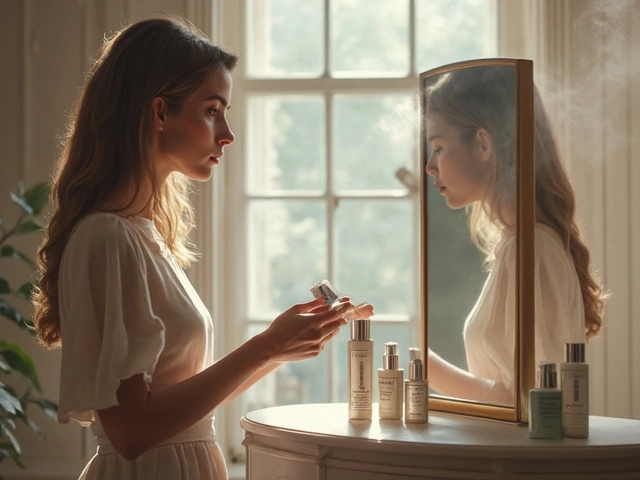As we navigate our thirties, forties, and beyond, it's natural to want to keep our skin looking vibrant and healthy. But with an overwhelming number of anti-aging options flooding the market, finding what truly works can be quite a task. From natural remedies you've heard your grandmother swear by to high-tech procedures making buzz in beauty circles, the options seem endless.
But fret not, for help is at hand. In this article, we will uncover a variety of effective anti-aging treatments, suitable for different skin types and ages. By the end, you'll have a clearer idea of the choices available and which might be best tailored to your unique skin concerns. Join us on this journey to youthful, glowing skin.
- Understanding Skin Aging
- Popular Skincare Ingredients
- Natural Remedies for Anti-Aging
- Professional Treatments and Procedures
- Tailoring Treatments to Your Skin Type
- Integrating Anti-Aging Into Daily Routine
Understanding Skin Aging
Skin aging is a natural and gradual process influenced by a variety of factors, both internal and external. As we age, the skin undergoes several changes that affect its texture, appearance, and resilience. One of the primary internal factors is the reduction in collagen and elastin production. These proteins provide structure and elasticity to the skin, and their decline results in wrinkles and sagging. Additionally, skin cell turnover slows down with age, leading to a dull complexion. Hormonal changes, especially in women around menopause, also contribute to skin thinning and dryness.
Externally, the most significant factor in skin aging is sun exposure. Ultraviolet (UV) rays are powerful and can damage the DNA in skin cells, leading to premature aging, also known as photoaging. This manifests as fine lines, wrinkles, sunspots, and a leathery texture. Pollution is another culprit. It exposes the skin to free radicals, which can break down collagen and cause inflammation. Lifestyle choices such as smoking and diet affect skin health as well. Smoking reduces blood flow to the skin, depriving it of oxygen and nutrients, while a diet low in antioxidants can hasten the aging process.
Genetic and Lifestyle Factors
Genetics play a role in how our skin ages, determining skin type and tone, which can affect susceptibility to signs of aging. However, lifestyle choices often have a more significant impact. Regular use of skincare products containing SPF, antioxidants, and other active ingredients can help in the long run. Staying hydrated and maintaining a balanced diet rich in vitamins C and E are critical to supporting skin health at any age. Stress reduction techniques such as meditation and yoga have also shown to be beneficial for the skin as they reduce cortisol levels, which when elevated, can accelerate the breakdown of collagen.
"The more UV exposure you have, the more solar elastosis you'll see," says Dr. Susan Taylor, a professor of dermatology at the University of Pennsylvania. "It is the number one cause of preventable skin aging."
Understanding these elements provides the groundwork for addressing skin aging with effective anti-aging strategies. Knowing the causes helps tailor proactive solutions that encompass protective measures, treatment choices, and lifestyle adjustments. As science advances, more innovations in skincare and treatments continue to emerge, offering hope for those seeking to maintain a youthful appearance while embracing the natural path of aging.
Popular Skincare Ingredients
Diving into the world of skincare can sometimes feel like deciphering an elaborate puzzle. With science-backed innovations continually emerging, it's essential to familiarize ourselves with the active ingredients that are truly making waves. These components have been tested by time and by modern research, ensuring they deliver noticeable results. Among the most notable ingredients that have secured their position as the frontrunners in the quest for anti-aging, a few stand out prominently.
First and foremost, let's talk about Retinol, a derivative of vitamin A. It's revered for its ability to boost collagen production, reduce the appearance of fine lines, and even out skin texture. While retinol’s touted benefits are vast, it can sometimes cause initial irritation, which is why dermatologists often advise starting with a lower concentration. Similarly, Vitamin C, another powerhouse ingredient, has risen in prominence due to its brightening properties. As an antioxidant, it neutralizes free radicals, helping to protect the skin from environmental damage. If used consistently, it can help fade sunspots and impart a radiant glow.
"Antioxidants like Vitamin C are crucial in fighting free radicals and are becoming indispensable in the anti-aging arsenal." - Dr. Emily Lin, Dermatologist
Hydrators and Exfoliants
While the importance of classic ingredients is undeniable, the advent of new hydrators and exfoliants cannot be overlooked. Hyaluronic Acid, for instance, has gained a reputation for its unparalleled hydrating capabilities. This naturally occurring molecule can hold up to a thousand times its weight in water, plumping the skin and providing it with a dewy look. The key to maximizing its benefits is to apply it to damp skin and layer a moisturizer over it, sealing in the hydration. On the other hand, exfoliants like Alpha Hydroxy Acids (AHA) play a crucial role in removing dead skin cells, revealing a smoother complexion beneath. They facilitate better absorption of subsequent products and can be particularly transformative for those with dull or uneven skin.
Another dynamic category of ingredients is peptides. These small proteins signal the skin to produce more collagen and elastin, which are fundamental to maintaining elasticity and firmness. The diverse array of peptides available means there’s usually one suited for every skin type. Regularly incorporating them into a skincare regime can yield lasting results and bolster overall skin health. As science advances, peptides are continuously being refined, leading to their increasing popularity in both serums and creams.
A Look into Natural Ingredients
Of course, singling out synthetic ingredients would be incomplete without acknowledging nature’s bounty. Natural oils like Rosehip and Jojoba are gaining traction for their nourishing properties and ability to enhance overall skin texture. Rosehip oil, brimming with fatty acids and vitamins, is particularly celebrated for its regenerative qualities, helping to diminish the appearance of scars and blemishes. Meanwhile, Green Tea Extract, another notable natural inclusion, offers both anti-inflammatory and antioxidant benefits, soothing the skin while protecting it from environmental stressors.
Incorporating these skincare ingredients into one’s routine doesn't always mean using them all at once. It's about understanding which ingredients are compatible with each other and how they align with specific skin concerns. Embarking on the anti-aging journey necessitates a careful balance, allowing the skin to gradually adapt and respond. Ultimately, the choice of ingredients should reflect individual needs and the pace at which one is comfortable progressing.

Natural Remedies for Anti-Aging
When it comes to battling the signs of aging, many individuals are turning back to nature to find effective solutions. The allure of anti-aging remedies found in everyday foods and plants isn't just a trend; it's rooted in centuries of folk wisdom and increasingly supported by modern research. From the humble avocado to exotic green tea and beyond, these natural products brim with vital nutrients that promise to nourish the skin and combat those pesky signs of getting older.
Take, for instance, the extraordinary power of antioxidants found in many fruits and vegetables. Berries, rich in Vitamins C and E, help combat free radicals that damage our skin's collagen, thereby aiding in maintaining its youthful appearance. Regular consumption of blueberries, strawberries, and citrus can impart a natural glow and increased elasticity. Likewise, incorporating nutrient-rich foods like carrots, loaded with beta carotene, can assist in maintaining the skin’s resilience and preventing fine lines. It’s as simple as adding a colorful salad to your plate or whipping up a tasty smoothie.
Harnessing the benefits of oils is another natural approach proving effective for skincare. Coconut oil, with its moisturizing properties, is a versatile ally in the battle against dryness, one of the chief culprits of aged skin. Its natural fatty acids work wonders when applied regularly to areas prone to wrinkles. Argan oil, often dubbed 'liquid gold,' is rich in essential fatty acids and Vitamin E, making it an excellent moisturizer as well as a reducer of inflammation and redness.
“Aging is a fact of life. Looking your age is not.” - Dr. Howard Murad
Using teas like green tea both internally and as an extract in skincare products can vastly improve skin's appearance by reducing inflammation and evening out the complexion. Green tea is packed with polyphenols, which have been shown to protect skin from sun damage when consumed or applied topically. So enjoying a cup of this fragrant tea not only refreshes but rejuvenates your skin from the inside out.
In addition, lifestyle changes play a vital role when it comes to natural anti-aging treatments. Ensuring adequate sleep, hydration, and stress reduction contribute significantly to a youthful exterior. Regular exercise, besides keeping one fit and active, enhances circulation and delivers more oxygen to skin cells, keeping them healthy and radiant. Combining these simple steps with an awareness of what we put in and on our bodies goes a long way in maintaining youthful, vibrant skin.
Professional Treatments and Procedures
When it comes to achieving and maintaining youthful skin, professional treatments and procedures have garnered immense popularity and trust over time. The options range from non-invasive and minimally invasive techniques to more intensive surgical procedures, each catering to different needs and preferences. Often, the choice of treatment depends on individual goals, age, and specific skin conditions.
Let's delve into some widely recognized professional anti-aging treatments. One non-invasive method gaining traction is laser therapy, which utilizes concentrated light beams to improve skin texture, tone, and elasticity by stimulating collagen production. This approach is known for its precision and minimal downtime, making it a favored choice amongst those seeking subtle but significant changes. Another popular option is microdermabrasion, which exfoliates the skin's surface using fine crystals or diamond tips, revealing fresher skin beneath.
For those looking for noticeable transformations without going under the knife, dermal fillers and injectables offer a promising alternative. These include neurotoxins like Botox, which relax facial muscles, thereby reducing the appearance of fine lines and wrinkles. Similarly, fillers such as hyaluronic acid can restore lost volume or enhance facial contours, offering instant results that can last for months. A valuable insight comes from a renowned dermatologist who stated,
"Dermal fillers have revolutionized the way we can address aging without surgery, providing a natural and refreshed look with minimal recovery time."
Innovative techniques like radiofrequency and ultrasound treatments are also making waves. Both methods are designed to penetrate deeper skin layers to tighten and lift without incisions, making them ideal choices for tightening sagging skin. With consistent advances in technology, these procedures are becoming more effective and accessible. Interestingly, some hair-growth treatments have adapted similar technologies to boost results in facial skin rejuvenation.
On the surgical front, procedures like facelifts or eyelid surgeries are known for delivering long-term results. These methods involve removing excess skin and repositioning underlying tissues to achieve a youthful appearance. Although more invasive, the results are often dramatic and lasting, attracting those who wish for a significant change. It's worth mentioning these procedures require a more extended recovery period and should always be performed by experienced surgeons.
When considering any professional anti-aging treatment, consultation with a healthcare provider is essential. Understanding the benefits, risks, and recovery associated with each allows individuals to make informed decisions tailored to their particular needs and desired outcomes. In addition, it's important to verify the credentials and expertise of the professional administering the treatment to ensure safety and efficacy.
Lastly, here is a quick comparison of the effectiveness of popular procedures:
| Treatment Type | Effectiveness | Downtime |
|---|---|---|
| Laser Therapy | High | Minimal |
| Botox | Moderate | None |
| Facelift | Very High | Lengthy |
The world of professional anti-aging treatments is expansive and filled with options to suit diverse needs and preferences. By staying informed and consulting with experts, achieving and maintaining youthful, glowing skin is within reach.

Tailoring Treatments to Your Skin Type
Choosing the right anti-aging treatment for your skin can feel much like a daunting journey through an intricate maze. Each path, or option, may seem lined with promises of youthful glows, yet only one is truly meant for you. Identifying your specific skin type is paramount—this is the beacon that will guide your quest. Are you blessed with normal skin, unburdened by excess oil or dryness? Or perhaps your skin leans towards being oily, prone to shininess and the occasional breakout? Then there's dry skin, often thirsting for moisture, or the temperamental combination skin that juggles both dry and oily patches. And let's not forget the sensitive skin, which cries out at the mere hint of irritation. Understanding your skin type allows you to select products and treatments that will work harmoniously, lowering the risk of adverse reactions and maximizing benefits.
Once your skin type is understood, we can delve into the myriad of skincare options. For those with normal skin, maintaining the balance is key. Gentle cleansers and light moisturizers with ingredients like hyaluronic acid can work wonders here. Oily skin, on the other hand, benefits from products that help control sebum without stripping skin of its natural oils. Ingredients like salicylic acid or clay masks can be quite beneficial. Meanwhile, dry skin requires rich, emollient creams; think along the lines of ingredients like glycerin or ceramides. Combination skin might need you to skillfully balance treatments: perhaps targeting oil control in the T-zone while applying more moisture to the cheeks. Sensitive skin, however, needs the utmost care with hypoallergenic and fragrance-free products to avoid irritation.
"The best approach is tailored one," says renowned dermatologist Dr. Nadia Isaacs. "While anti-aging treatments abound, understanding your skin type and its unique needs unlocks the path to true effectiveness."
A trend gaining traction is personalized skincare, where treatments are designed based on individual skin assessments. Advanced technology allows for personalized serums, often taking into account genetic markers and environmental factors. This precision customized approach is like having a suit tailored to fit only you—it meets your exact needs and conditions. There's also a growing interest in the dosha-specific approach, a concept rooted in Ayurvedic tradition that aligns treatments with your body’s constitution. It's seen as merging ancient wisdom with modern beauty science.
Maintaining a youthful look requires not just knowing your skin type but staying consistently attentive to its ever-changing needs. Seasonal changes, lifestyle alterations, even stress levels can impact what your skin requires. It means regularly reassessing and adjusting your skincare regimen, much like swapping your wardrobe to fit the climate shifts. While you may have started using one treatment, you might need to tweak it down the line. This adaptability ensures that your skincare remains effective and that you always put your best face forward, quite literally. Monitoring your skin's reaction to treatments is just as crucial as selecting them in the first place.
Integrating Anti-Aging Into Daily Routine
Adopting an effective anti-aging routine is much more than an exercise in vanity; it's a genuine investment in your skin's health and longevity. Establishing a daily regimen is vital, and knowing what works best for you can significantly impact your skin's youthful glow. The first and perhaps the most critical step is cleansing. Using a gentle cleanser will help remove any impurities without stripping your skin of its natural oils. The idea is to maintain the skin's balance, ensuring it's not too oily nor dry, providing a suitable environment for your subsequent treatments to work optimally.
Incorporating anti-aging treatments into your daily life means embracing certain products as necessities, not luxuries. Think of products rich in antioxidants, like vitamin C and E serums, which help fight off free radicals. These radicals are pesky molecules that cause skin cells to age prematurely. Adding hyaluronic acid to your routine aids with hydration, plumping the skin, and smoothing fine lines. Don’t forget sunscreen even on cloudy days! Using broad-spectrum SPF protects against both UVA and UVB rays, which are known to contribute to signs of aging.
A nightly routine shouldn't be overlooked either. It’s during sleep that your body regenerates cells at its peak. Retinoids or retinols are often recommended as essential skincare ingredients. They encourage skin turnover and stimulate collagen production, essential for reducing wrinkles. Moisturizing in the evening is also crucial to repair the skin barrier. Choosing a night cream with peptides can not only firm the skin but also enhance its elasticity.
Creating these habits can sometimes feel overwhelming. Yet, routines become second nature after time and when they start showing results, it becomes motivation enough to stay consistent. Remember, it's about nurturing your skin gently, consistently, and thoughtfully.
As Dr. Howard Murad, a renowned dermatologist, once noted,
"Healthy skin is a reflection of overall wellness, and your face is the first thing others notice. Make sure it radiates all the positivity and health you embody."This statement reminds us that while topical treatments are crucial, a comprehensive approach also factors in nutrition, exercise, and stress management. Ensuring a balanced diet rich in fruits, vegetables, and omega-3 fatty acids can further enhance skin health.
While skincare may seem like a daunting task for beginners, start slow. Introduce one product at a time so you understand what works for your skin and what doesn't. This way, you’ll also be able to monitor any reactions accurately. Document your journey to help note changes and adjust treatments accordingly. Often, sharing these experiences with friends or online communities can provide further support and insight. A friendly discussion sometimes reveals tips not often highlighted in glossies.
Staying informed is empowering. Whether it's knowing the newest anti-aging breakthrough or myths debunked, knowledge is your best tool. With patience and persistence, this daily routine becomes a ritual of self-care, one that pays off with each glance in the mirror that reflects a younger, glowing you.


